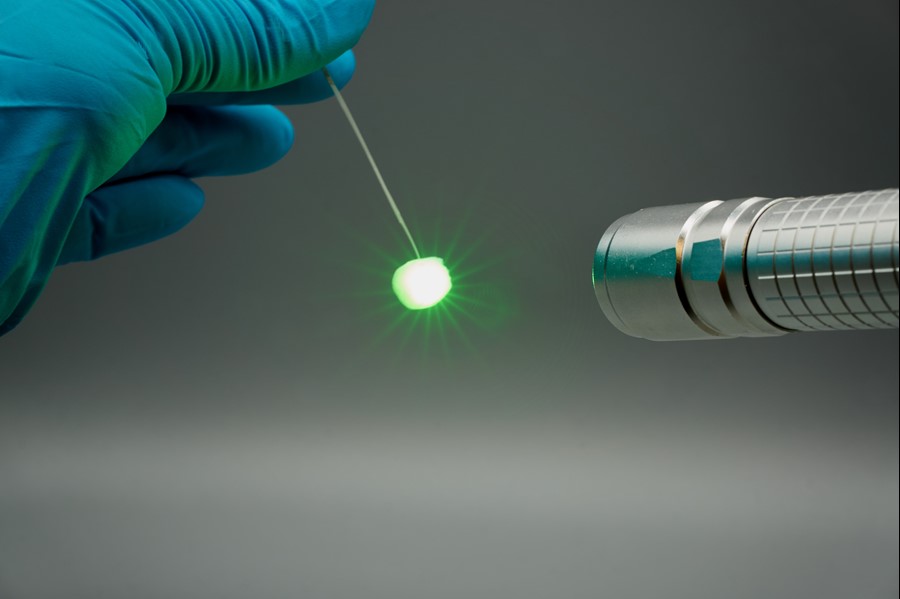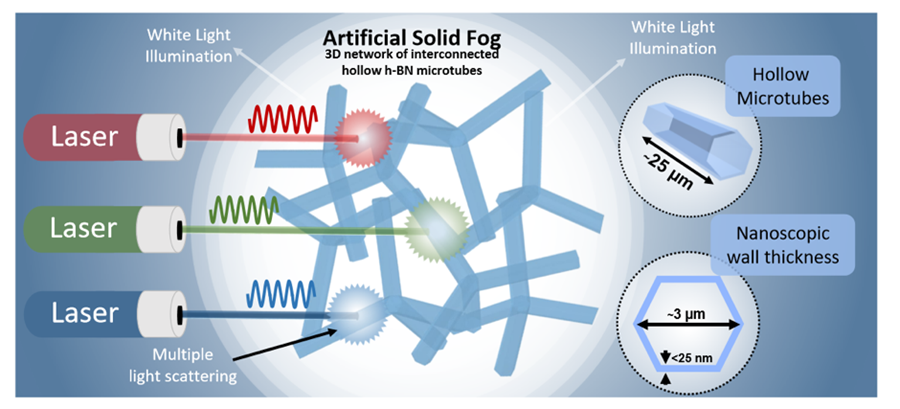Artificial fog made of hexagonal boron nitride helps lasers shine brighter and more colourful
Graphene Flagship researchers have devised a light diffuser based on hexagonal boron nitride (hBN) – a layered material with the same hexagonal structure as graphene, but with complementary properties – able to convert directional laser beams into a luminous source that scatters light in all directions.
Published in Nature Communications, this highly efficient technology can find applications in automotive headlights and projectors, and in the lighting of stadiums and large buildings. Graphene Flagship partners Kiel University, Cambridge Graphene Centre, University of Trento, Hamburg University of Technology, Queen Mary University of London, the Edoardo Amaldi Foundation and collaborators were involved in this study.
Laser diodes (LDs) outperform ubiquitous light emitting diodes (LEDs) in terms of light output per unit area, but still suffer from a few drawbacks linked to their physics, as well as the use of phosphor materials to generate white light. The Graphene Flagship team developed an alternative method to create white light, and other colours, by merging red, green and blue (RGB) LD beams with the help of an hBN foam diffuser, called aero-BN, which consists of more than 99.99% air. This diffuser withstands lasers around ten times stronger than state-of-the-art phosphors, meaning that small-scale light sources with much higher intensities can become a reality.
The aero-BN diffuser acts like an artificial fog. It is made of a semi-transparent web of randomly arranged and interconnected hBN hollow microtubes. Measuring 25 micrometers in length and 100 to 3000 nanometers in diameter, these microtubes are dispersed at low density – well below 1 mg/cm3. The three laser beams penetrate deeply into the artificial fog, where they are strongly and randomly scattered multiple times by the nanoscopic walls of the microtubes. At an optimum intensity of all three lasers, white light is emitted, and by varying the ratio of intensity of the RGB lasers, this method allows for the choice of a rainbow palette of colours. This represents a major improvement in comparison with existing phosphor-based devices that only produce a certain colour.
Fabian Schütt, from Graphene Flagship partner Kiel University, says: "Conventionally, we tend to think of lasers as highly directional and intense light beams of a single colour, such as laser pointers. This study shows that laser light can actually be used to create a homogenous white light source suitable for illumination applications, just like light bulbs, and also be expanded into more colours. We are currently looking for industrial partners to bring our new technology to the market, and searching for ways to scale-up the process."
The high amount of light scattering inside the diffuser is also the reason for the strong reduction in speckle contrast, a pattern of dark and bright spots caused by the monochromatic nature of the laser light – which is unpleasant for the human eye and limits the uses of LDs as real light sources. In this study, a large number of speckle patterns were superimposed and averaged out, and they became invisible to the human eye. This is a strict requirement for LD-based lighting, which is still unmet by today's commercially available diffuser systems.
"This is an excellent example of how we can utilise the functionality of layered materials on the macroscopic scale. The foam is capable of withstanding extremely high-powered lasers, allowing for the creation of small-scale light sources with extremely high intensities," explains Xinliang Feng, the Graphene Flagship's Work Package Leader for Functional Foams and Coatings.
Andrea C. Ferrari, Science and Technology Officer of the Graphene Flagship and Chair of its Management Panel, adds: "Boron nitride has been the first companion of graphene, since the Graphene Flagship journey started. While this material is mostly used as substrate for electronic and photonic devices based on graphene and related material, this study breaks new ground showing how it can be arranged to produce an ideal light diffuser. This is a great example of how foams and coatings based on layered materials are coming to the fore for industrial applications."
Banner image: the extremely lightweight Aero-BN foam is used to scatter directional laser beam light in all directions. (Credit: Florian Rasch)
References
F. Schütt, M. Zapf, S. Signetti, J. Strobel, H. Krüger, R. Röder, J. Carstensen, N. Wolff, J. Marx, T. Carey, M. Schweichel, M.I. Terasa, L. Siebert, H.K. Hong, S. Kaps, B. Fiedler, Y.K. Mishra, Z. Lee, N.M. Pugno, L. Kienle, A.C. Ferrari, F. Torrisi, C. Ronning, R. Adelung. ‘Conversionless efficient and broadband laser light diffusers for high brightness illumination applications ’, Nat. Commun., 11 (1437), (2020)

The extremely lightweight Aero-BN foam is used to scatter directional laser beam light in all directions. (Credit: Florian Rasch)

The Aero-BN diffuser is made of a semi-transparent web of randomly arranged and interconnected hexagonal boron nitride (hBN) hollow microtubes. Red, green and blue laser beams penetrate deeply into the artificial fog, where they are strongly and randomly scattered multiple times by the nanoscopic walls of the microtubes. As a result, white light is emitted. (Credit: Nature Communications)




